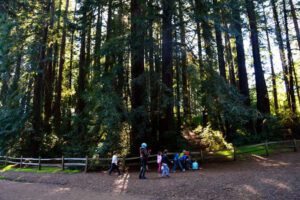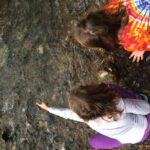by Becca Heisler, Wilderness Torah – Berkeley, CA
Parshat Acharei Mot, in the book of Vayikrah (Leviticus), brings a follow-up to the deaths of Aaron’s sons, Nadav and Avihu, who were consumed by fire before G-d for offering an unholy sacrifice. As a result of this misdeed, Aaron is tasked with atonement: first, he is commanded to make special sacrifices. Then, he bequeaths all of the transgressions of the Israelites upon a goat (the “scapegoat ”) and sends it into the desert. These rituals are the origins of our modern Day of Atonement, Yom Kippur.
My reactions to Acharei Mot were scattered: fascination, apathy, confusion, sadness, curiosity, anger. Underlying all of those reactions was a question: what brings us back every year to study the commandments, laws, and rituals of Vayikrah that no longer govern our daily lives?
We read this parshah during the fourth week of counting The Omer . Each week of the Omer corresponds to one of the lower seven sephirot (attributes or emanations of G-d), and this week is the week of netzach (Endurance). Each day is an exploration of the relationship between netzach and another sephirah – First is chesed (love), next gevurah (boundedness), then tiferet (harmony), netzach (endurance), hod (splendor), yesod (abundance), and finally malchut (sovereignty). Through the counting of the omer, we examine the love in endurance, the boundedness in endurance, the harmony in endurance, and so on throughout the week.
My questions after reading Acharei Mot alongside this week of netzach have left me marvelling at the endurance of Jewish tradition. How has Judaism maintained relevance, despite its basis in text written thousands of years ago as a guidebook for an agrarian, desert-dwelling tribe?
Judaism is a tradition of cycles: lunar cycles, solar cycles, annual cycles of holidays and Torah readings, and life cycles marked by Jewish milestones. Acharei Mot translates to “after death;” What follows death in the cycle of life? Rebirth, reinvention, regeneration, new beginnings. This parshah shows that after the deaths of Nadav and Avihu, the observance of Yom Kippur was born; their literal deaths serve as a metaphor for the end of retributive atonement and the creation of a new way of processing sin and misdeed. Yom Kippur is part of our cyclical holiday calendar, grounding us each year with forgiveness and offering a chance to begin anew.
Over many thousands of years, the Jewish people have also been part of a macro-cycle of cultural regeneration. At Wilderness Torah, we have embraced Judaism’s flexibility as a living tradition; here, cultural regeneration looks like reclaiming the earth-based origins of Judaism that have fallen by the wayside as Jewish populations have migrated, shifted, and urbanized. The Torah is bursting with our history of nature connection and moments of revelation and divinity in the wilderness, and we have heeded the call to build community around that interpretation of Torah.

In B’hootz, our Sunday School in the woods, we tell and act out stories about Jewish connection to the earth; this week, we honored the changing seasons with the story of Honi the Circle Maker. We celebrate the natural world as we experience it, learning and sharing blessings for everything from the first flowers of the season to a freakish snowstorm in the East Bay. We provide space for hitbodedut, the Jewish spiritual practice of spending time alone in nature, by finishing each week quietly listening to what the creek or the birds or the trees might have to teach us.

The best part about this is that Wilderness Torah is not alone in our work. JOFEE organizations from around the country have come together to build a movement of Jewish communities who are more connected to the earth through farming, spirituality, outdoor education, sustainability, and ritual. In this week of netzach and beyond, may we accept the Torah as not just a symbolic tree of life, but a living tradition, as adaptable to our changing world as the trees are to the forest ecosystem. Judaism endures because every year we return to these words of Torah to reconnect, reinterpret, and re-envision what our Judaism can be; our roots in Torah hold strong as we branch out and embrace change.
Becca Heisler grew up in the Chicago area, spending her summers at OSRUI, a Jewish camp in Wisconsin. It was there that she cultivated her love of nature and her love of Judaism, and after 7 summers as a camper and 3 as a counselor/trip leader, she knew that the intersection of those two loves would be her calling. She gained skills and knowledge in these two areas through extensive involvement with Hillel, Tufts Wilderness Orientation, and Tufts Mountain Club. After graduating with degrees in Environmental Studies and Math, Becca continued along this journey serving as a program coordinator for Tufts Wilderness Orientation, and then, after swapping coasts, participating in the Urban Adamah fellowship. She is overflowing with gratitude to serve as Wilderness Torah’s second JOFEE fellow, and thrilled to be a part of the vibrant Bay Area Jewish community.
Editor’s Note: Welcome to D’varim HaMakom: The JOFEE Fellows Blog! Most weeks throughout the year, you’ll be hearing from the JOFEE Fellows: reflections on their experiences, successful programs they’ve planned and implemented, gleanings from the field, and connections to the weekly Torah portion and what they’ve learned from their experiences with place in their host communities for the year. Views expressed are the author’s and do not necessarily represent Hazon. Be sure to check back weekly!
